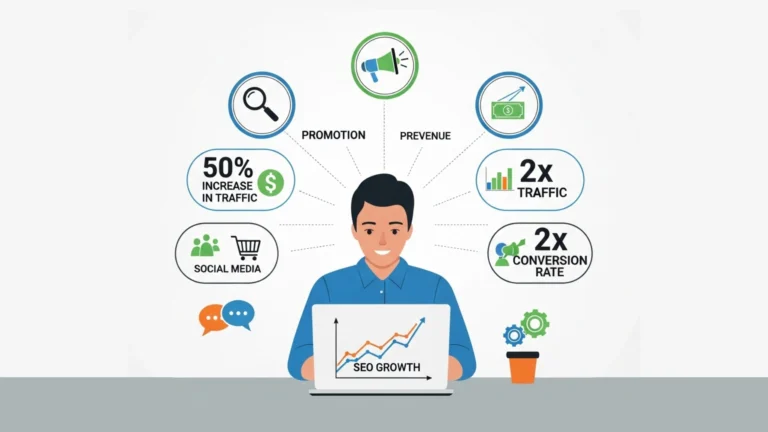
Finally, you’re ready to launch your startup. But you have one more thing left on the “how to launch a startup successfully” list: a professional website. You landed this blog using the keywords “how to build a startup website,” and that’s exactly what this blog will show you.
Read on for the best startup website guide you can get.
Why Your Startup Needs a Professional Website
In today’s age, having a strong online presence is essential for every business, particularly new businesses. A website for your startup meets one of the requirements for an online presence.
What is a website? A website is basically the digital storefront of your business. Rather than the traditional brick-and-mortar store, a website serves as an extension of your brand. The benefits of a startup website cannot be overemphasized, as it can be the deciding factor between gaining and losing customers.
A well-designed website draws passersby on search engines, of course, and gives your business the best first impression ever. That’s one thing you mustn’t overlook as a startup. Besides a perfect design layout, there are other things you must do to stand out—SEO. Search engine optimization is the final trick that pushes your website to the right audience.
Here’s How To Create a Startup Website
1. Define your purpose and audience
The first thing on the list is to know your startup from the inside to the outside. There’s very little progress you could make if you didn’t know what you represent as a business. Want to write a pitch deck to seal deals? Want to write an investor-ready business plan? You need to define your business.
Here’s how to define your purpose-start from the very beginning. What problem does your startup solve? That’s its purpose. What about its audience? Your target audience is the group of people most likely to use your products or services. They are the people whose pain point your business aims to resolve.
Once you’ve identified your target audience and purpose, designing a website becomes easier. You’ll simply design a website and fill it with content solely for their benefit. For clarity, use the questions in the outline below:
- Define your company’s mission: it’s standard that every company has its own mission statement; yours shouldn’t be different. So, define what yours is.
- Know your target market: who needs your product? Where are they? What’s their social status? At this point, you’ll need a buyer persona.
A buyer persona is a carefully created profile of your ideal client. It helps you piece together the tiny details of your target audience. With a well-constructed buyer persona, you can improve your marketing strategy with personalized marketing campaigns.
- Define your unique selling proposition: pinpoint what makes your brand unique. If you were the client, what would attract you the most about the company? Figuring this out will help you with the website’s layout.
Tip: Always keep your purpose simple. Too many words or points can muddle up the target’s mind. Also, keep your target audience straightforward; narrow it down.
2. Check out the competition
For every endeavor, the logical thing is to size up the competition. Honestly, entering a market without knowing the standard is like walking into a gang fight without a weapon.
The first step is to correctly identify your competition, emphasizing ‘correctly’. As an example, if you’re a skincare brand for women, your competition isn’t another random skincare brand. You should dig deeper; check brands that are in the same niche as you. Also, their target audience matters. While some skincare brands cater to older people, others choose young women in their reproductive years. So, no need to start from scratch; just build on what they have going on.
Once you’ve identified the correct set of competitors, you can then scrutinize their websites and get inspiration for your startup website. It doesn’t end there; visit their blogs, sign up for their email list (if they offer newsletters), and follow (or stalk) them on social media. That way, you get a first-row view of what they’re doing right or wrong.
Want a competitive analysis for your startup? Our team at Techdella can provide professional insights and strategic recommendations. Learn more about our web research services.
3. Establish your website’s foundation
Creating a website for your startup requires three essential infrastructure elements:
Choose the Right Domain Name: Your domain name is your digital address; it should be memorable, professional, and aligned with your brand. A strong domain name adds credibility and makes your small business website easier to find.
Key considerations:
- Keep it short and easy to spell
- Avoid numbers and hyphens
- Include your business name or relevant keywords
- Check availability across social media platforms
- Secure a .com extension when possible
Domain names typically come with annual renewal fees, though some providers offer free options for startups on a budget.
Need free domain names? Check out Freenom and Dot TK.
Select Reliable Web Hosting for Startups: Your web hosting provider determines your website’s speed, security, and uptime. Look for:
- Fast loading speeds (critical for SEO and user experience)
- 99.9% uptime guarantee
- Robust security features (SSL certificates, DDoS protection)
- Scalability as your startup grows
- Responsive customer support
- Automated backups
- A hosting provider
Choose a Website Builder for Startups: Modern website builders for startups eliminate the need for coding knowledge. Popular options include WordPress, Wix, Squarespace, and Webflow. Consider:
- Ease of use for non-technical founders
- Available startup website templates
- Customization flexibility
- E-commerce capabilities (if needed)
- Mobile-responsive design options
- SEO features and plugins
Create Your Sitemap: A sitemap visualizes your website’s structure and user navigation flow. Map out all pages (home, about, services, blog, contact) and how users move between them. This planning ensures logical, intuitive navigation for your website user experience.
Confused about the technical setup? Let Techdella handle your domain, hosting, and website infrastructure so you can focus on growing your business.
4. Design your website’s look and feel
Building a website isn’t complete without a user-friendly website layout. From the competitor analysis, you have an idea of how your website should look. Here are some tips for building an attractive website.
- Keep it simple: a busy website would only divert focus and turn the visitor away. So, minimalistic designs all the way
- High-quality images: images have proven to be a powerful way to communicate. So, create a good first impression with good images
- Be consistent; inconsistency screams, “Look at me; I’m naive.” So, maintain the same tone, style, color scheme, and even font throughout the website.
- Use great headlines: your headlines should be attention-grabbing (not exaggerated or misleading); that’s what draws people to the content of your website.
- Use CTAs: Call-to-actions, e.g., call now!, start my subscription, click here, etc., to trigger your audience to make decisions immediately. So, use them sufficiently.
But if you’d prefer a professionally designed website that truly reflects your brand and drives results, our expert web design team can help. Let us handle the tech, so you can focus on growing your business.
5. Create high-quality content
Now that you’ve built your website, next comes traffic. For that, you need high-quality content.
When generating content, you should know that your content is an extension of the website. It has to maintain a similar tone, style to the website and align with the business goals as well. The rule of thumb for website content is professional, informative, and engaging, so take note.
- Avoid errors in your website’s content by all means
- Keep it clear, concise, and easy to read
- Enrich it with keywords (avoid keyword stuffing) to help it rank on search engines.
- Make it visually appealing with images, videos, and other multimedia
Again, consistency plays an important role in creating a startup website. Make sure you publish new content regularly to improve your ranking on search engines and keep the traffic going. As you publish content, make sure you promote it on social media; it’s another way to boost visibility.
If you need help producing consistent, SEO-friendly content that matches your brand voice and drives results, our content marketing team at Techdella can support you with strategy, creation, and promotion, so you can focus on growing your business.
6. Promote your website
The emergence of the internet changed how businesses operate. In the past, businesses made use of print advertisements, television commercials, etc., to push themselves to their audiences. Now, the virtual world runs the show.

In present times, enterprises need a website as a contact point and digital workspace. Since you’ve successfully created and launched a startup website filled with valuable, informative content, it’s time to promote it through every channel possible.
There are several ways to do this, which include;
- social media marketing: Almost everyone’s on social media, including your target audience. You can leverage social media to boost website traffic by sharing engaging content and CTAs
- Email marketing: Some think no one reads emails anymore; that’s false. A considerable number of people check their mail regularly. So, you should use newsletters, promotions, etc., with clear CTAs to move attention to your website. Just make sure the emails are personalized and relevant to the recipient’s interests.
- Targeted ad campaigns: Targeted ad campaigns are a sure way to reach the desired audience. You can use platforms like Google Ads and Facebook Ads to target certain demographics.
Just make the ad copy clear and compelling.
While all these sound easy, it can be time-consuming and stressful. That’s where marketing automation comes in.
Marketing automation is the use of software to simplify marketing tasks. With it, startups can eliminate repetitive tasks like social media posting and take on a more personalized approach to marketing. Marketing automation gets the job done faster and more efficiently.
Want to clear marketing off your table? Are you having trouble getting the desired marketing results? Let Techdella handle it all. Because we are a team of marketing experts, we give you marketing automation with the perfect human-to-software ratio. Contact us now.
7. Monitor your progress
This is the last in this startup website guide. You need to keep track of your website’s analytics to know what’s going on because there’ll be adjustments to make over time.
You can use Google Analytics for an in-depth breakdown of your website’s traffic and demographics.
And as you track your progress, remember that the words on your website play a big role in how visitors respond. If you want your copy to connect, convert, and communicate your brand story effectively, explore this guide on why working with a copywriting agency can help your business grow.
Finally…
We’ve come to the end of our journey. You’ve learnt how to create and launch a website for your startup and monitor its progress (great job!). Here are a few things you can do to improve your website:
- Conduct user-testing
- Make your website user-friendly
- Watch your website’s loading speed
- Keep your design current
- Ensure your site is secure
- And update your content regularly.
If you’re ready to take things a step further or need expert guidance tailored to your business, book a free discovery call with us at Techdella. Let’s help you build a high-performing website that drives real results.




